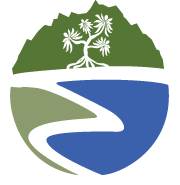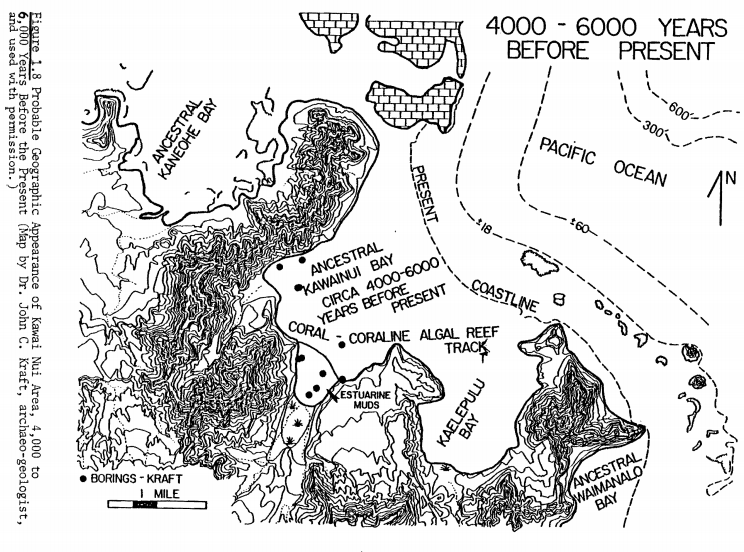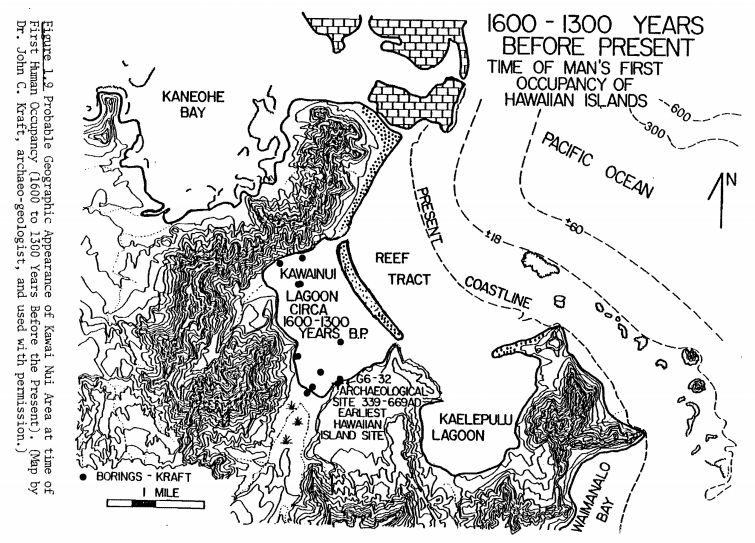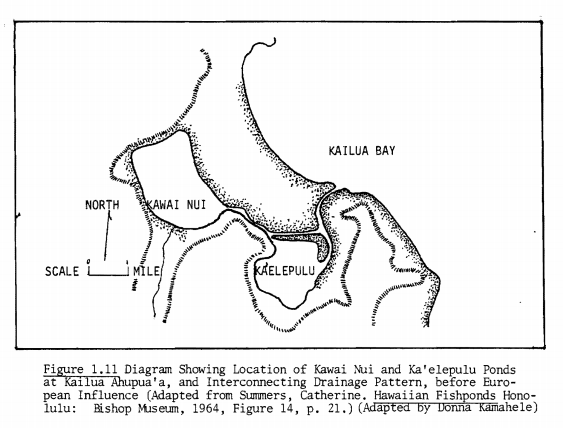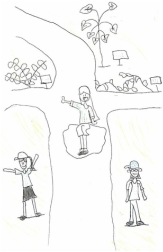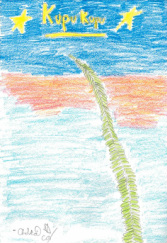Kawainui
Core samples from underneath Kawai Nui Marsh reveal marine coral and calcium containing deposits under clays and organic sediment. These findings indicate that from approximately six thousand to about four thousand years before the present, (See Figure 1.8) Kawai Nui Marsh was an open saltwater marine bay, similar to the present day Kaneohe Bay. Coral sands washed up on the silty beaches along the inland portion of the bay, while the peripheral slopes supported a natural tropical forest. This marine embayment, having by then become a lagoon, with carpeted mud bottom, was existing here when the earliest Polynesian pioneers discovered Hawaii, about 1500 years before present. (See Figure 1.9) In fact, archaeological and geological evidence from Kawai Nui and nearby areas indicate that O'ahu was one of the earliest areas occupied by these Polynesian voyagers, as early as the fourth century A.D. At that time, the accretion barrier, that would eventually close off the lagoon, was already formed from the north to south ends of the bay on the reef tract. The sand barrier at the makai end (i.e. the ocean side) of the lagoon could have supported coconuts and hala. And the wet plains in the valley would have provided natural garden plots to plant taro shoots for lo’i farming. Thus, this area was rich in potential resources. It is no wonder that it was among those earliest occupied in Hawai'i.
Throughout this earliest settlement period, the streams flowing off the Ko'olau mountains and through the taro gardens in the valley deposited increasing amounts of sediment and soil on the shores of the lagoon. A peat layer capable of supporting salt-tolerant vegetation began to develop, creating fringing marshes around the lagoon, an inviting environment for nesting waterbirds and migrating water fowl - a source of feathers and food. The streams continued to lay their sediments and soils while the ocean continued building the beach barrier, aided - perhaps - by increasingly sophisticated Hawaiian stream flow management. These natural forces continued to supply the nutrients necessary for support of the flourishing fringing marshes while probably expanded in area to encompass more and more of the open water lagoon. Meanwhile, the accretion barrier continued to expand from the north to the south end of the bay, as the fringing marshes grew By this time, approximately 1200 years ago, the Hawaiians converted approximately two hundred fifty acres along the mauka (inland) edge of the marsh-fringed lagoon into a rich and productive taro-growing area by controlling the streams and damming the waters into a network of irrigation ditches or "auwai" approximately 500 years ago. A four hundred fifty acre inland freshwater fishpond or "loko wai" was also established, in which awa and mullet were raised. This inland freshwater aquaculture system was separated by an expanding barrier beach from the sea, and drained by a mile-long canal linking it with the drainage system of the nearby Ka'elepulu fishpond and its taro complex. Water from the mountain streams continued to feed the taro fields. The fishponds were fed by nutrient-rich water from the taro, which nurtured algae on which the fish fed. Hawaiians harvested the fish and taro, while maintaining the fishponds and taro fields. The continued productivity of the district as believed to be assured by the presence of a mo'o or guardian spirit of Kawai Nui, which manifested herself either in reptilian or beautiful woman-like forms, and whose presence in the pond was said to have been marked by the yellow hue imparted to the grasses and bullrushes there. Many freshwater fishponds were thought to have such a mo'o or guardian spirit. The mo'o at Kawai Nui was called Hau-wahine. She and her companion mo'o of Ka'elepulu looked after the welfare of the people by insuring a plentiful supply and variety of food to be harvested from the pond. If the chief's land agent oppressed the people of the area or became indifferent to their needs, the mo'o would take away the fish from the pond. |
"Thank you for teaching us about the native plants and invasive ones. I liked when we got to get dirty and dig a hole for the Uala or sweet potato." |
"Thank you for teaching me about Kaha Garden and all the plants and the weeds that take over. I also took a Kukui nut to try and plant at home because I think it will interest my family." |
"Now I know many of the ways Hawaiians used our native plants instead of us going to a store or something to figure it out. Now I will use some of these strategies." |
|
| ||||
